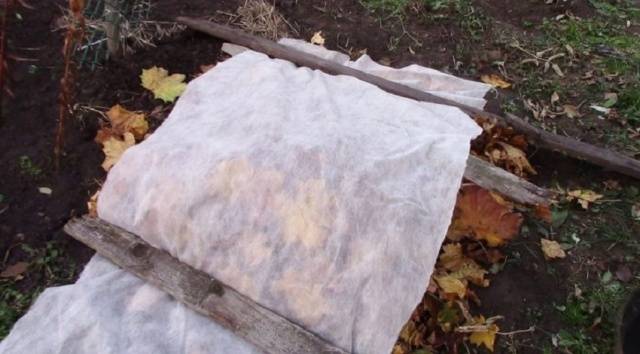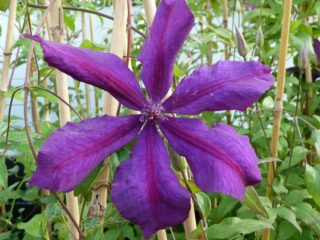Clematis "Ashwa" is a representative of the family of perennial compact vines. The length of an adult plant is 1.5 – 2 m. Gardeners and landscape designers are happy to use the very decorative appearance of clematis “Ashwa” to decorate plots (see photo):
Description of the variety
Climbing plants are a special type of decorative landscapers. In addition to the weaving stem, the bush attracts attention with beautiful flowers. The description of clematis "Ashwa" states that the flower can produce up to 100 buds in one growing season. The colors of large inflorescences are very bright and varied. According to reviews, clematis "Ashwa" is found with flowers of pink, blue, crimson, purple, and white colors. By combining different tones, you can perfectly decorate buildings or terraces.
The popular name for clematis is clematis. The structural features of plants are the presence of strong leaf petioles, with the help of which the shoot is held on a vertical plane. Clematis variety "Ashwa" is a light-loving plant, so with sufficient lighting the vine grows very quickly. And in the shade it produces weak flowering and growth.
The decoration of Ashwa is flowers. They are large, bright, round in shape.
The plant forms buds on the shoots of the current year, which, according to the international classification, classifies the large-flowered clematis “Ashwa” to group C. The variety blooms during the summer until mid-September. The site is a riot of color all season long. The flower consists of 5 wavy petals.Each petal has a vertical stripe of a different color (red).
In addition to describing the clematis "Ashwa", high-quality plant photos help gardeners make a choice of variety.
Tips for gardeners
Some nuances inherent to the plant should be known before planting it on the site:
Liana variety "Ashva" grows in one place for 20-25 years. If plants are planted in groups, then the distance between bushes is maintained at least 1 m.
The site is chosen to be sunny and protected from the winds. When there are gusts of wind, the shoots get tangled and broken, the flowers are damaged, and the decorative value of the plant is significantly reduced.
In order for the clematis to develop normally and bloom profusely for a long time, it is necessary to choose the right support. Choose one that is convenient for the plant and attractive to the owner.
Overheating of the root system of the flower is unacceptable. To protect it, the plant is blocked from the south side with other low shrubs, perennials or a fence. To protect the roots of "Ashva" from the sun, low flowering species - marigolds, calendula - can be planted in the area around the trunk. This technique will help protect clematis from pests.
According to gardeners, clematis variety “Ashwa” demonstrates its peak decorative potential at the age of 3 to 7 years. Then the roots become heavily intertwined and require increased watering and nutrition.
The most careful care is needed for young bushes aged 2-3 years. Twice a year (spring and autumn) they are fed with rotted manure with the addition of ash and phosphorus-potassium fertilizer.
The main stages of growing clematis variety "Ashwa" are planting and care.
Planting clematis
Gardeners propagate clematis themselves or purchase seedlings of elite varieties. Clematis large-flowered caper "Ashwa" is a source of pride for Dutch breeders. Plant seedlings are bought in a specialized store and stored until planting at a temperature of 0 to +2⁰С. If it is noticed that the buds begin to sprout, the plant is transferred to a cool but well-lit place. This must be done so that the shoots do not stretch.
Clematis prefers loose, loamy, fertile soil. Naturally, with a slightly alkaline or neutral reaction. An acidic environment for clematis “Ashva” is unsuitable, just like heavy and damp soil.
According to the description of the variety, a distance of 15-20 cm must be maintained between clematis “Ashwa” and the wall. This requirement is due to the fact that the soil near the buildings is dry. Therefore, clematis in this zone grow slowly, bloom very weakly and often die. Near a residential building, increase the space between the wall and the clematis to 30 cm. Care must be taken to ensure that water from the roof does not fall on the shoots.
The best time for planting clematis "Ashwa", according to descriptions and reviews from gardeners, is considered to be the end of May. It is important to avoid the danger of return frosts.
The planting hole for clematis is dug in the form of a cube with sides of 60 cm. The top layer of soil from the hole is cleared of weed, mixed with:
- humus or compost (2-3 buckets);
- peat and sand (1 bucket each);
- superphosphate (150 g);
- complex mineral fertilizer for flowers (200 g);
- bone meal (100 g);
- chalk (200 g);
- wood ash (200 g).
For light soil, increase the amount of peat and add clay. Give the soil time to settle. This takes 2-3 days. A drainage layer - sand or perlite - is placed at the bottom of the hole.
If the roots of the Ashva seedling have dried out a little, then it is soaked in cold water for 3-4 hours. If the plant was purchased in a container, then it is immersed in water for 20 minutes. When the substrate is saturated with moisture, you can begin planting.
Hybrid clematis "Ashva" is planted with the root collar deepened by 7-10 cm. From the soil level, the seedling is buried 3-5 cm in heavy soil, and in sandy loam by 5-10 cm. The distance between the "Ashva" bushes is left at least 60- 70 cm. Immediately water and mulch the area around the trunk. In the first 10 days, shade the bushes from the scorching sun.
What to do if you managed to purchase Ashva seedlings in late autumn? They are placed in a basement with a temperature of no more than +5°C. The roots are covered with a moistened mixture of sand and sawdust. Be sure to pinch the plants to prevent shoots from growing. Repeat pinching after 2-3 weeks.
Bush care
Basic care for clematis consists of:
Glaze. It must be timely and complete. The requirement of clematis for moisture is known to flower growers. "Ashwa" vines need abundant watering during the growth period. However, swampy and constantly humid places are completely unsuitable for growing clematis "Ashva" ("Ashva"). The period after the snow melts is especially dangerous. At this time, it is necessary to ensure the outflow of moisture to avoid waterlogging of the root system. The Ashwa variety does not need frequent watering. It is important to monitor the condition of the soil and not allow it to dry out completely. When watering, make sure that the stream of water is not directed towards the center of the bush. In spring, the bushes are watered with lime milk prepared from 200 g of lime and 10 liters of water. This volume is consumed per 1 sq. m area.
Feeding. If the plant was planted last year, then the bushes are fed at least 4 times per season and only after watering. Clematis do not like high concentrations of nutrients in the soil. Ashva uses organic and mineral compounds for fertilizing. It is recommended to alternate them. In summer, monthly watering with a solution of boric acid or potassium permanganate (2 g per 10 liters of water) works well, sprayed with a solution of urea (0.5 tbsp per bucket of water). When the plant blooms, feeding is stopped. Excessive nutrition will shorten the flowering period.
Weeding. An important stage that should not be neglected. Weeds can seriously deprive a plant of moisture and nutrients, so it is necessary to fight them and mulch the soil.
Trimming. The plant's buds are formed on young shoots of the current year. This suggests that clematis “Ashwa” belongs to the plants of the 3rd pruning group. Therefore, there is no point in saving old shoots. Clematis "Ashwa" is pruned every spring. Young plants planted in the spring are sure to form in the fall (October - early November) in the same year. This will help the seedling to take root well and overwinter. In the spring, all old shoots are cut into 2 buds.
If the shoot is frozen, it is removed onto the ring. The same applies to two- and three-year-old clematis vines.
Shelter for the winter. Before covering, clematis must be pruned and old leaves removed. If the event is carried out correctly, then clematis “Ashwa” can withstand frost up to 45°C. But the main danger is waterlogging of the soil in early spring or autumn. At night, water can freeze and the ice harms the roots. Therefore, it is necessary to carefully cover the soil around the bush.
Sheltering is carried out in November, when the soil begins to freeze and the air temperature is between -5°C and -7°C. Cover with earth, weathered peat, and add spruce branches on top. In the spring, the cover is removed gradually.
More information about autumn events:
Clematis "Ashwa" is most widely used in landscape design projects. Lush arches strewn with large flowers can decorate any area. “Ashva” is especially useful when decorating walls, terraces, gazebos or supports.
Not only the description and photo of clematis “Ashwa”, but also reviews from those who already grow the flower are of great help to gardeners.















Please tell me, I bought clematis Ashwa, now it’s October, what should I plant or put in the basement until spring, I live in the Trans-Baikal Territory, thanks in advance
Good afternoon, Vera!
The best time to plant clematis in the fall is September. At this time there are no night frosts yet, and before frost the flowers have enough time to take root and prepare for winter. For complete rooting, clematis need at least 4-5 weeks. And although autumn this year spoils us with warmth, we still advise you to keep the flower in the basement until spring.
In the Trans-Baikal Territory there are already slight frosts at night. It's better not to take risks. Clematis simply does not have time to prepare for frost and may freeze.